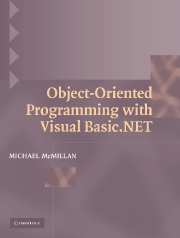Book contents
- Frontmatter
- Contents
- Preface
- Chapter 1 An Overview of the Visual Basic.NET Language
- Chapter 2 An Overview of Object-Oriented Programming
- Chapter 3 Structures
- Chapter 4 Classes
- Chapter 5 Access Modifiers
- Chapter 6 Abstract Classes and Interfaces
- Chapter 7 Implementing the IEnumerable and IComparable Interfaces
- Chapter 8 Designing and Implementing Exception Classes
- Chapter 9 Design Patterns and Refactoring
- Chapter 10 Object Internals: Reflection and Attributes
- Chapter 11 Object Persistence: Serialization
- Chapter 12 Building a Windows Application
- Chapter 13 Database Programming Using ADO.NET
- References
- Index
Chapter 7 - Implementing the IEnumerable and IComparable Interfaces
Published online by Cambridge University Press: 06 July 2010
- Frontmatter
- Contents
- Preface
- Chapter 1 An Overview of the Visual Basic.NET Language
- Chapter 2 An Overview of Object-Oriented Programming
- Chapter 3 Structures
- Chapter 4 Classes
- Chapter 5 Access Modifiers
- Chapter 6 Abstract Classes and Interfaces
- Chapter 7 Implementing the IEnumerable and IComparable Interfaces
- Chapter 8 Designing and Implementing Exception Classes
- Chapter 9 Design Patterns and Refactoring
- Chapter 10 Object Internals: Reflection and Attributes
- Chapter 11 Object Persistence: Serialization
- Chapter 12 Building a Windows Application
- Chapter 13 Database Programming Using ADO.NET
- References
- Index
Summary
Data we create via object creation cannot be treated in the same way native data (integers, strings, etc.) are treated. When we are working with strings, for example, it is easy to compare two strings to see if they are equivalent. In contrast, when we are working with two class objects, where each object is a composite of multiple data types, how we report the result of comparing the two objects is not obvious. Visual Basic.NET provides a special interface, IComparable, to aid us in making these types of comparisons.
Class objects also present a problem when we want to store them in a data structure and retrieve them using a For Each loop. The VB.NET compiler cannot automatically return an enumerator for class objects stored in an ArrayList or some other data structure, so we must provide the enumeration code. The.NET Framework again helps us in this task by providing an interface, IEnumerable, that we can implement. In this chapter we'll discuss how to implement both interfaces and provide several examples to see exactly how they're used.
THE ICOMPARABLE INTERFACE
A class type usually represents a complex data type comprising components of one of the built-in data types (String, Integer, Boolean, etc.). For example, an Employee class might include data for an employee's name (including the first, middle, and last name), social security number, salary, the department in which he or she works, etc. If we want to compare two Employee objects to see if they are the same, how do we do it?
- Type
- Chapter
- Information
- Object-Oriented Programming with Visual Basic.NET , pp. 179 - 191Publisher: Cambridge University PressPrint publication year: 2004



